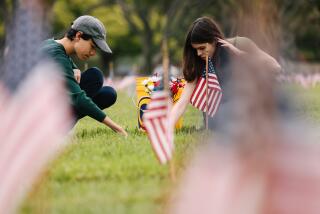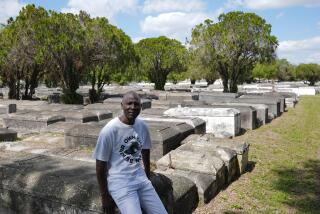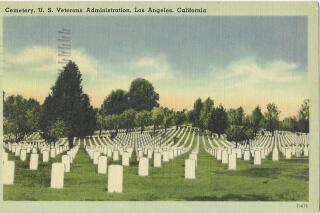OXNARD : Masonic Group Labors to Restore Historic Graveyard
- Share via
With rakes, hoes and a rumbling skip loader, about 150 members of Masonic groups from throughout Ventura County spent Saturday restoring a neglected cemetery and unearthing part of Oxnard’s past.
Before the work began, knee-deep ice plant all but obscured century-old plots at the Hueneme Masonic Cemetery. Headstones were missing or knocked down.
But by afternoon, order began to re-emerge at the three-acre graveyard.
Three dumpster loads of ice plant were hauled off, revealing more than a dozen plots containing the grave sites of pioneer families: Saviers, Arnold, Arundell and Mahan. The headstones, some weighing hundreds of pounds, were uprighted with the help of a skip loader, then cemented in place.
“This was in a way like an archeological dig,” cleanup organizer Steve Cooley said excitedly as he dusted off a headstone from 1899. “You’re talking about real history here.”
Using a plot map drawn up in 1900 as a guide, the volunteers plan to return in coming months to clear off more graves now marked with about 100 wooden stakes. Eventually, they want to catalogue all of the names.
The Hueneme Masonic Cemetery lies between Pleasant Valley and Etting roads in south Oxnard, hemmed in by orange groves and a housing subdivision. At the center of the cemetery--where all of Saturday’s work took place--is a diamond-shaped open space surrounded by the plots of city founders and early settlers of the region.
One granite marker identifies the grave of Curdin N. Kenyon, who served as a sergeant in Company L of the 4th Michigan Cavalry during the Civil War.
For decades, the corporation set up to maintain the cemetery, the Hueneme Masonic Cemetery Assn., has paid state taxes on the property but has been unable to afford its upkeep.
Saturday’s effort began as a community project for Job’s Daughters, an organization of teen-age girls affiliated with the Masons, Cooley said.
But after seeing the cemetery’s deteriorated condition, organizers realized the task was bigger than expected and recruited help from all of the county’s Mason lodges and women’s auxiliary groups.
“It’s kind of mushroomed,” Cooley said. “We had no idea what we were getting into.”
More to Read
Sign up for Essential California
The most important California stories and recommendations in your inbox every morning.
You may occasionally receive promotional content from the Los Angeles Times.










